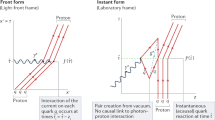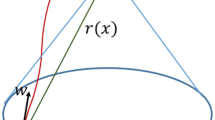Abstract
The validity of just a few physical conditions comprising the Einstein equivalence principle (EEP) suffices to ensure that gravity can be understood as spacetime geometry. The EEP is therefore subject to ongoing experimental verification, with present-day tests reaching the regime in which quantum mechanics becomes relevant. Here we show that the classical expression of the EEP does not apply in such a regime. The EEP requires equivalence between the rest mass-energy of a system, the mass-energy that constitutes its inertia, and the mass-energy that constitutes its weight. In quantum mechanics, the energy contributing to the mass is given by a Hamiltonian operator of the internal degrees of freedom. Therefore, we introduce a quantum expression of the EEP—equivalence between the rest, inertial and gravitational internal energy operators. Validity of the classical EEP does not imply the validity of its quantum formulation, which thus requires independent experimental verification. We propose new tests as well as re-analysing existing experiments, and we discuss to what extent they allow quantum aspects of the EEP to be tested.
This is a preview of subscription content, access via your institution
Access options
Access Nature and 54 other Nature Portfolio journals
Get Nature+, our best-value online-access subscription
$29.99 / 30 days
cancel any time
Subscribe to this journal
Receive 12 print issues and online access
$209.00 per year
only $17.42 per issue
Buy this article
- Purchase on Springer Link
- Instant access to full article PDF
Prices may be subject to local taxes which are calculated during checkout



Similar content being viewed by others
References
Einstein, A. Über das Relativitätsprinzip und die aus demselben gezogenen Folgerungen. Jb. Radioakt. 4, 411–462 (1907).
Philoponus, J. Corollaries on Place and Void (transl. Furley, D.) (Cornell Univ. Press, Ithaca, NY, 1987). .
Will, C. M. The confrontation between general relativity and experiment. Living Rev. Relativ. 17, 4 (2014).
Rosi, G. et al. Quantum test of the equivalence principle for atoms in coherent superposition of internal energy states. Nat. Commun. 8, 15529 (2017).
Zych, M., Costa, F., Pikovski, I. & Brukner, Č. Quantum interferometric visibility as a witness of general relativistic proper time. Nat. Commun. 2, 505 (2011).
Pikovski, I., Zych, M., Costa, F. & Brukner, Č. Universal decoherence due to gravitational time dilation. Nat. Phys. 11, 668–672 (2015).
Zych, M. Quantum Systems under Gravitational Time Dilation (Springer, Cham, 2017).
Reinhardt, S. et al. Test of relativistic time dilation with fast optical atomic clocks at different velocities. Nat. Phys. 3, 861–864 (2007).
Chou, C.-W., Hume, D., Rosenband, T. & Wineland, D. Optical clocks and relativity. Science 329, 1630–1633 (2010).
Zych, M., Costa, F., Pikovski, I., Ralph, T. C. & Brukner, Č. General relativistic effects in quantum interference of photons, classical and quantum. Gravity 29, 224010 (2012).
Zych, M., Pikovski, I., Costa, F. & Brukner, Č. General relativistic effects in quantum interference of ‘clocks’. J. Phys. Conf. Ser. 723, 012044 (2016).
Bushev, P. A., Cole, J. H., Sholokhov, D., Kukharchyk, N. & Zych, M. Single electron relativistic clock interferometer. New J. Phys. 18, 093050 (2016).
Pikovski, I., Zych, M., Costa, F. & Brukner, Č. Time dilation in quantum systems and decoherence. New J. Phys. 19, 025011 (2017).
Einstein, A. Ist die Trägheit eines Körpers von seinem Energieinhalt abhängig? Ann. Phys. 323, 639–641 (1905).
Einstein, A. Über den Einfluss der Schwerkraft auf die Ausbreitung des Lichtes. Ann. Phys. 35, 898–908 (1911).
Rainville, S. et al. World Year of Physics: A direct test of E = mc 2. Nature 438, 1096–1097 (2005).
Aguilera, D. et al. STE–QUEST—test of the universality of free fall using cold atom interferometry. Class. Quantum Gravity 31, 115010 (2014).
Schlippert, D. et al. Quantum test of the universality of free fall. Phys. Rev. Lett. 112, 203002 (2014).
Altschul, B. et al. Quantum tests of the Einstein equivalence principle with the STE–QUEST space mission. Adv. Space Res. 55, 501–524 (2015).
Williams, J., wey Chiow, S., Yu, N. & Müller, H. Quantum test of the equivalence principle and space-time aboard the International Space Station. New J. Phys. 18, 025018 (2016).
Fray, S., Diez, C. A., Hänsch, T. W. & Weitz, M. Atomic interferometer with amplitude gratings of light and its applications to atom based tests of the equivalence principle. Phys. Rev. Lett. 93, 240404 (2004).
Charman, A. et al. Description and first application of a new technique to measure the gravitational mass of antihydrogen. Nat. Commun. 4, 1785 (2013).
Colladay, D. & Kostelecký, V. A. CPT violation and the standard model. Phys. Rev. D 55, 6760–6774 (1997).
Drummond, I. T. Quantum field theory in a multimetric background. Phys. Rev. D 88, 025009 (2013).
Lightman, A. P. & Lee, D. L. Restricted proof that the weak equivalence principle implies the Einstein equivalence principle. Phys. Rev. D 8, 364–376 (1973).
Haugan, M. P. Energy conservation and the principle of equivalence. Ann. Phys. 118, 156–186 (1979).
Lämmerzahl, C. Quantum tests of the foundations of general relativity. Class. Quantum Grav. 15, 13–27 (1998).
Kostelecky, V. & Lane, C. Nonrelativistic quantum Hamiltonian for Lorentz violation. J. Math. Phys. 40, 6245–6253 (1999).
Hohensee, M. A., Müller, H. & Wiringa, R. Equivalence principle and bound kinetic energy. Phys. Rev. Lett. 111, 151102 (2013).
Kostelecký, V. A. & Vargas, A. J. Lorentz and CPT tests with hydrogen, antihydrogen, and related systems. Phys. Rev. D 92, 056002 (2015).
Gasperini, M. Testing the principle of equivalence with neutrino oscillations. Phys. Rev. D 38, 2635–2657 (1988).
Mann, R. & Sarkar, U. Test of the equivalence principle from neutrino oscillation experiments. Phys. Rev. Lett. 76, 865–868 (1996).
Alan Kostelecký, V. & Mewes, M. Lorentz and CPT violation in neutrinos. Phys. Rev. D 69, 016005 (2004).
Bonder, Y. et al. Testing the equivalence principle with unstable particles. Phys. Rev. D 87, 125021 (2013).
Nordtvedt, K. Jr. Quantitative relationship between clock gravitational ‘red-shift’ violations and nonuniversality of free-fall rates in nonmetric theories of gravity. Phys. Rev. D 11, 245–247 (1975).
Storey, P. & Cohen-Tannoudji, C. The Feynman path integral approach to atomic interferometry. A tutorial. J. Phys. II 4, 1999–2027 (1994).
Müntinga, H. et al. Interferometry with Bose–Einstein condensates in microgravity. Phys. Rev. Lett. 110, 093602 (2013).
Greenberger, D. M. The role of equivalence in quantum mechanics. Ann. Phys. 47, 116–126 (1968).
Davies, P. C. W. & Fang, J. Quantum theory and the equivalence principle. Proc. R. Soc. Lond. A 381, 469–478 (1982).
Viola, L. & Onofrio, R. Testing the equivalence principle through freely falling quantum objects. Phys. Rev. D 55, 455–462 (1997).
Lämmerzahl, C. On the equivalence principle in quantum theory. General Relativ. Gravit. 28, 1043–1070 (1996).
Alvarez, C. & Mann, R. Testing the equivalence principle in the quantum regime. General Relativ. Gravit. 29, 245–250 (1997).
Adunas, G., Rodriguez-Milla, E. & Ahluwalia, D. V. Probing quantum violations of the equivalence principle. General Relativ. Gravit. 33, 183–194 (2001).
Davies, P. C. W. Quantum mechanics and the equivalence principle. Class. Quantum Grav. 21, 2761–2772 (2004).
Kajari, E. & et al. Inertial and gravitational mass in quantum mechanics. Appl. Phys. B 100, 43–60 (2010).
Okon, E. & Callender, C. Does quantum mechanics clash with the equivalence principle and does it matter? Eur. J. Phil. Sci. 1, 133–145 (2011).
Herrmann, S. et al. Testing the equivalence principle with atomic interferometry. Class. Quantum Grav. 29, 184003 (2012).
Nobili, A. M. et al. On the universality of free fall, the equivalence principle, and the gravitational redshift. Am. J. Phys. 81, 527–536 (2013).
Amelino-Camelia, G., Ellis, J., Mavromatos, N., Nanopoulos, D. V. & Sarkar, S. Tests of quantum gravity from observations of γ-ray bursts. Nature 393, 763–765 (1998).
Maartens, R. & Koyama, K. Brane-world gravity. Living Rev. Relativ. 13, 5 (2010).
Damour, T. Theoretical aspects of the equivalence principle. Class. Quantum Grav. 29, 184001 (2012).
Lebed, A. G. Inequivalence between gravitational mass and energy due to quantum effects at microscopic and macroscopic levels. Int. J. Mod. Phys. D 26, 1730022 (2017).
Birrell, N. D. & Davies, P. C. W. Quantum Fields in Curved Space (Cambridge Univ. Press, Cambridge, 1982).
Schlamminger, S., Choi, K.-Y., Wagner, T., Gundlach, J. & Adelberger, E. Test of the equivalence principle using a rotating torsion balance. Phys. Rev. Lett. 100, 041101 (2008).
Orlando, P. J., Mann, R. B., Modi, K. & Pollock, F. A. A test of the equivalence principle(s) for quantum superpositions. Class. Quantum Grav. 33, 19LT01 (2016).
Geiger, R. & Trupke, M. Proposal for a quantum test of the weak equivalence principle with entangled atomic species. Phys. Rev. Lett. 120, 043602 (2018).
Acknowledgements
We thank I. Pikovski and F. Costa for comments on early drafts of this manuscript; and C. Kiefer, D. Giulini and G. Tino for discussions. We acknowledge support from the ARC Centre EQuS CE110001013, the University of Queensland (UQ Fellowship grant no. 2016000089), the Templeton World Charity Foundation (TWCF 0064/AB38), the ÖAW Innovationsfonds ‘Quantum Regime of Gravitational Source Masses’, the Doctoral Programme CoQuS and the research platform TURIS. This publication was made possible through the support of a grant from the John Templeton Foundation. The opinions expressed in this publication are those of the authors and do not necessarily reflect the views of the John Templeton Foundation. M.Z. acknowledges the traditional owners of the land on which the University of Queensland is situated, the Turrbal and Jagera people.
Author information
Authors and Affiliations
Contributions
M.Z. and Č.B. contributed to all aspects of the research, with the leading input from M.Z.
Corresponding author
Ethics declarations
Competing interests
The authors declare no competing interests.
Additional information
Publisher’s note: Springer Nature remains neutral with regard to jurisdictional claims in published maps and institutional affiliations.
Supplementary information
Supplementary Information
Supplementary Notes and References
Rights and permissions
About this article
Cite this article
Zych, M., Brukner, Č. Quantum formulation of the Einstein equivalence principle. Nature Phys 14, 1027–1031 (2018). https://doi.org/10.1038/s41567-018-0197-6
Received:
Accepted:
Published:
Issue Date:
DOI: https://doi.org/10.1038/s41567-018-0197-6
This article is cited by
-
Test of the gravitational redshift with single-photon-based atomic clock interferometers
Quantum Frontiers (2024)
-
General formalism of the quantum equivalence principle
Communications Physics (2023)
-
Quantum reference frames for an indefinite metric
Communications Physics (2023)
-
Scientific value of the quantum tests of equivalence principle in light of Hilbert’s sixth problem
Pramana (2023)
-
Consistency of Quantum Computation and the Equivalence Principle
Foundations of Science (2023)



